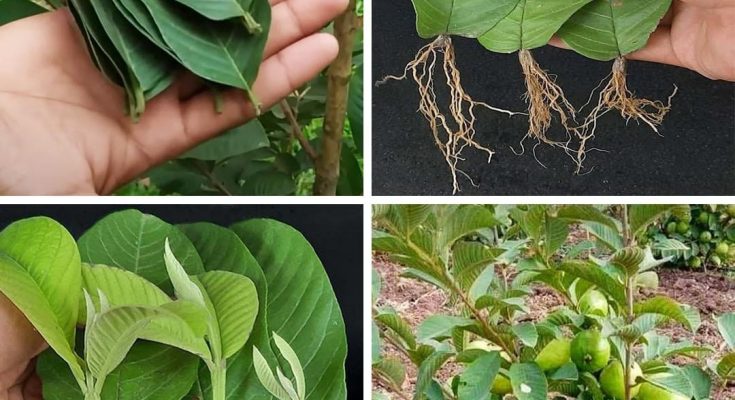. Choose Healthy Leaves
Start by selecting mature, healthy guava leaves free from pests or diseases. Healthy leaves provide the best chance of success when propagating new growth.
Using a clean, sharp knife or scissors, cut the guava leaves into sections. Ensure each section includes part of the central vein, as this is crucial for rooting. Aim for cuttings about 4–6 inches in length. Gather several cuttings to increase your chances of success.
3. Enhance with Rooting Hormone (Optional)
To improve rooting success, dip the cut ends of the leaf cuttings into a rooting hormone. Follow the manufacturer’s instructions to ensure proper application. While optional, this step can significantly boost root development.
Fill a pot or seedling tray with well-draining potting mix or soil. Plant the leaf cuttings horizontally, burying the cut ends slightly into the soil. Space the cuttings a few inches apart to allow room for growth.
5. Create a Mini Greenhouse
Cover the pot or tray with a clear plastic bag or plastic wrap to retain humidity. This mini greenhouse effect helps maintain the moisture levels necessary for successful rooting.
Place the container in a warm spot with bright, indirect sunlight. Keep the soil consistently moist but not overly wet. Lightly mist the cuttings or water the soil as needed, ensuring a balance between moisture and aeration.
7. Exercise Patience
Rooting guava leaves is a slow process, often taking several weeks or even months. During this time, monitor the humidity inside the plastic enclosure and ensure the soil remains moist. Patience and consistent care are essential.
Once the cuttings develop roots and grow into small plants, they are ready for transplanting. Move them into larger pots or plant them directly in your garden. Choose a sunny spot, and continue providing adequate water and nutrients to support their growth.
Tips for Success

Understand the Challenges: Growing guava trees from leaves is experimental, and success is not guaranteed. Don’t be discouraged if some cuttings fail.
Experiment with Varieties: Some guava species may root more successfully than others. Test different varieties to determine the best fit for this method.
Avoid Overwatering: Overly wet soil can cause rot. Keep the soil moist but well-drained.
Maintain Humidity: High humidity is critical during the rooting phase. Ensure the plastic enclosure is doing its job effectively.
Growing guava trees from guava leaves is an exciting and educational project that offers a unique way to experiment with plant propagation. While it requires patience and may not always succeed, the process is rewarding for curious gardeners. For more reliable results, traditional methods like seeds or cuttings may be preferable, but trying this approach allows you to explore a fascinating facet of gardening. Give it a try, and you might just grow a beautiful guava tree from a simple leaf.



